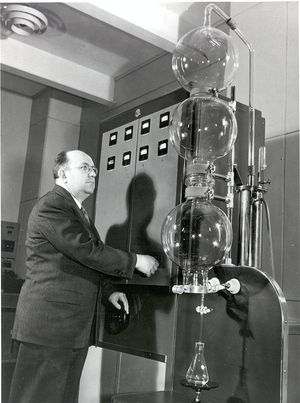George Brown
- Birthdate
- 1908/10/14
- Birthplace
- North Milwaukee, WI, USA
- Death date
- 1987/12/11
- Associated organizations
- RCA (Radio Corporation of America)
- Fields of study
- Communications
- Awards
- IEEE Edison Medal
Biography
George H. Brown was born on 14 October 1908, in North Milwaukee, Wisconsin. He majored in Electrical Engineering at the University of Wisconsin in the class of 1930, and he continued in postgraduate work at the university to earn his M.S. in 1931 and his Ph.D. in 1933. He joined the Radio Corporation of America in 1933 as a research engineer at Camden, NJ.
Early in his career, Dr. Brown was attracted by the challenge of transmission problems facing the radio broadcasting industry and he produced the theory and analytical deductions that led to his development of the directional antenna systems that are now standard in the transmission of AM and FM radio and in television broadcasting.
One of the notable results of his early research work was his translation of his theoretical conclusions into the AM Broadcasting Antennas that are in standard use throughout the world. In 1935, he followed this with development of the "turnstile" antenna. The turnstile concept offered for the first time an effective combination of high gain and broad bandwidth with a wave propagation pattern which made it possible to broadcast FM radio and television signals over long distances. Subsequently, Dr. Brown added to the design an absorbing resistor which resulted in increased bandwidth and permitted the simultaneous radiation of television pictures and sound from the same antenna.
In the late 1930's, he made a further contribution of basic importance to practical television service, the vestigial side-band filter which made possible the high resolution characteristic of broadcast television today.
During World War II, Dr. Brown designed and developed radio and radar antennas for military systems and was awarded a Certificate of Appreciation from the War Department for his contributions. He and his associates also developed a method for speeding the production of penicillin by means of radio-frequency heating techniques. As a recognized authority in the technical aspects of broadcast communications, Dr. Brown has played a prominent part in industry and government efforts through the years to formulate and establish standards for radio and television broadcasting. Through the 1950's he was responsible for instituting and leading a comprehensive technical and test program that demonstrated for the first time the advantages and the problems of UHF television broadcasting. Through the same period, he made significant contributions to the formulation of standards for commercial color television service as a participant in the work of the National Television System Committee and as an expert witness before the Federal Communications Commission.
Starting in 1952, Dr. Brown advanced through a series of positions of creasing importance in the research and engineering organizations of RCA Director of the Systems Research Laboratory, RCA Laboratories; Chief Engineer, RCA Industrial Electronic Products (1957); Vice President, Engineering, RCA; Vice President, Research and Engineering (1961); Executive Vice President, Research and Engineering (1965). He was a member of the Board Directors of RCA and of RCA Communications, Inc. Brown retired from RCA in 1972. Afterward he wrote his memoirs, entitled and part of which I was—Recollections of a Research Engineer.
Dr. Brown was a leading contributors to the technology of modern broadcast communications. As an engineer, administrator, and executive, he played a pioneering role in the development of theory, equipment, and standards vital to the commercial radio and television services.
Dr. Brown was a Fellow of the IEEE and of the American Association for the Advancement of Science, and a member of the National Academy of Engineering. He held 80 US patents and he contributed to a multitude of scientific and engineering journals. He was awarded the 1967 IEEE Edison Medal "For a meritorious career distinguished by significant engineering contributions to antenna development, electromagnetic propagation, the broadcast industry, the art of radio frequency heating, and color television."
Dr. Brown married Elizabeth Ward in 1932. They had twin sons- James W., who became a professor of mathematics at Oberlin College, and George H., Jr., became an electrical engineer. Dr. Brown took a special interest in Boy Scout activities received the coveted Silver Beaver Award for his work in scouting. Brown passed away on 11 December 1987.
Further Reading
National Academy of Engineering, “George H. Brown,” Memorial Tributes: National Academy of Engineering, Vol. 4 (Washington, D.C.: National Academy Press, 1991).

